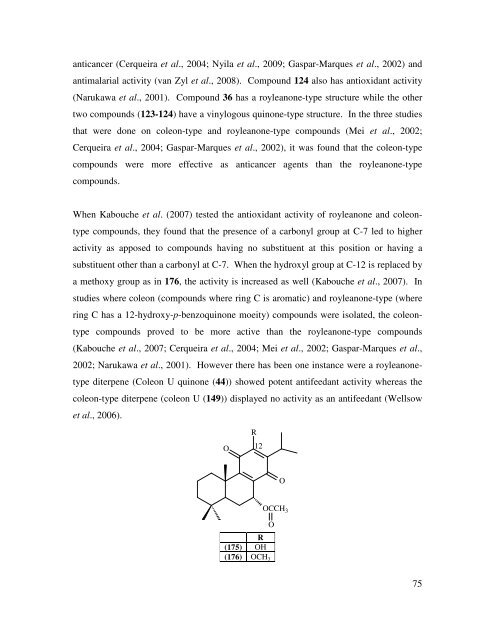university of kwazulu-natal faculty of science and agriculture school ...
university of kwazulu-natal faculty of science and agriculture school ...
university of kwazulu-natal faculty of science and agriculture school ...
Create successful ePaper yourself
Turn your PDF publications into a flip-book with our unique Google optimized e-Paper software.
anticancer (Cerqueira et al., 2004; Nyila et al., 2009; Gaspar-Marques et al., 2002) <strong>and</strong><br />
antimalarial activity (van Zyl et al., 2008). Compound 124 also has antioxidant activity<br />
(Narukawa et al., 2001). Compound 36 has a royleanone-type structure while the other<br />
two compounds (123-124) have a vinylogous quinone-type structure. In the three studies<br />
that were done on coleon-type <strong>and</strong> royleanone-type compounds (Mei et al., 2002;<br />
Cerqueira et al., 2004; Gaspar-Marques et al., 2002), it was found that the coleon-type<br />
compounds were more effective as anticancer agents than the royleanone-type<br />
compounds.<br />
When Kabouche et al. (2007) tested the antioxidant activity <strong>of</strong> royleanone <strong>and</strong> coleon-<br />
type compounds, they found that the presence <strong>of</strong> a carbonyl group at C-7 led to higher<br />
activity as apposed to compounds having no substituent at this position or having a<br />
substituent other than a carbonyl at C-7. When the hydroxyl group at C-12 is replaced by<br />
a methoxy group as in 176, the activity is increased as well (Kabouche et al., 2007). In<br />
studies where coleon (compounds where ring C is aromatic) <strong>and</strong> royleanone-type (where<br />
ring C has a 12-hydroxy-p-benzoquinone moeity) compounds were isolated, the coleon-<br />
type compounds proved to be more active than the royleanone-type compounds<br />
(Kabouche et al., 2007; Cerqueira et al., 2004; Mei et al., 2002; Gaspar-Marques et al.,<br />
2002; Narukawa et al., 2001). However there has been one instance were a royleanone-<br />
type diterpene (Coleon U quinone (44)) showed potent antifeedant activity whereas the<br />
coleon-type diterpene (coleon U (149)) displayed no activity as an antifeedant (Wellsow<br />
et al., 2006).<br />
O<br />
R<br />
12<br />
O<br />
OCCH 3<br />
O<br />
R<br />
(175) OH<br />
(176) OCH3<br />
75

















